Margaret Atwood MasterClass review synopsis
What you’ll learn: In this creative writing MasterClass, you’ll learn how to write a novel from esteemed writer Margaret Atwood. Atwood shows you how to create nuanced characters, how to identify the right point of view, and how the publishing industry works. Simply put, it’s a well-rounded introduction to novel writing.
How long does the Margaret Atwood MasterClass take? 3 hours and 43 minutes.
Similar courses: Shonda Rhimes: Writing for Television, N. K. Jemisin: Fantasy and Science Fiction Writing, Neil Gaiman: The Art of Storytelling, Joyce Carole Oates: The Art of the Short Story, Judy Blume: Writing a Novel for younger readers
Do I recommend Margaret Atwood’s MasterClass? Yes. This class is perfect for any writer hoping to write and publish a novel.
I was pretty excited to take this MasterClass. I’ve read some of Margaret Atwood’s works and thoroughly enjoyed watching the TV adaptations of The Handmaid’s Tale and Alias Grace. So when I saw she’d created a MasterClass, I was eager to jump in. The course ended up exceeding my expectations.
In this MasterClass, Atwood takes us through the process of writing a novel. She shows us how to create compelling characters, write realistic dialogue, and effectively research the history of your story to make it credible and believable.
She also shares details about the publishing industry, offering tips and advice from finding the right agent to dealing with inevitable rejections.
“If everything is perfect all the time, there isn’t a story.”
I’ve taken a few MasterClasses, but this one felt personal. Why? Because Atwood’s delivery of the course is charming, witty, and engaging. It really did feel like she was talking to me directly a lot of the time.

Now, let’s get on with the review so that you can see for yourself if the Margaret Atwood MasterClass is right for you. We’ll outline what the course offers and how much it’ll cost you, and we’ll look at some of the pros and cons to help you decide.
Disclosure: In the interest of full transparency, Codeless uses affiliate links in our MasterClass reviews to cover our site’s costs. Learn more
Our Verdict
Margaret Atwood’s MasterClass is thought-provoking and interesting, and it provides budding novelists with the tools they need to write a novel as soon as the class is over.
Margaret Atwood MasterClass Learn how to write a novel
PROS
- Atwood is a knowledgeable and engaging instructor.
- The course features case studies from her work.
- Atwood is honest about the reality of being a working writer.
CONS
- The course includes a lot of references to literary classics. If you haven’t read the books, you might not fully understand the point.
- The course is aimed mostly at writing novels.
- The course length is on the shorter side.
In this MasterClass review, you’ll learn:
A few frequently asked questions (FAQs)…
Let’s take a look at answers to some questions before we go into more detail.
Do I need a subscription to access this course?
MasterClass doesn’t offer any individually priced classes, so you’ll need a subscription to access the Margaret Atwood course. By subscribing, you’ll get access to the 180+ courses MasterClass offers in several categories, ranging from cooking, baking, interior design, photography, music, makeup, poker, and even negotiation.
How long is the MasterClass?
The class runtime is 3 hours and 43 minutes. It’s broken down into 23 videos ranging from 5–15 minutes in length.
Does MasterClass have a cancellation policy?
Yes. You can cancel at any time, but if you do so within the first 30 days, you get a full refund.
Why learn writing skills from Margaret Atwood?
Margaret Atwood ranks pretty high on the list of renowned and respected writers (more on this later). And if you want to develop your writing skills, you should learn from the best, right?
Is the Margaret Atwood MasterClass worth it?
Yes, I’d say that MasterClass is a good investment for anyone who wants to write a novel.
Check out the Margaret Atwood MasterClass
About Margaret Atwood
Margaret Atwood was born in 1939 in Ottawa, Ontario, Canada. Because of her father’s work in forest entomology, her family spent a lot of time living in the forests of northern Quebec. During this time, Atwood kept herself busy with books, which she cites as her reason for becoming a writer.
Atwood is a writer best known for her prose. Novels such as The Handmaid’s Tale, Oryx and Crake, and Alias Grace are some of her most well-known works. She’s also published collections of poetry, essays, and graphic novels. We won’t list them all here because it’s a pretty long list.
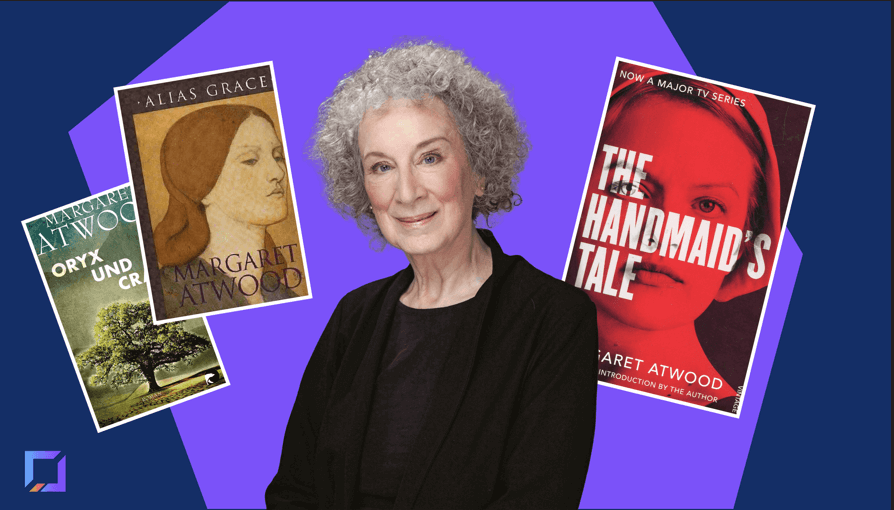
Atwood also has a long list of accolades to her name. She’s won two Booker Prizes, the Franz Kafka Prize, the Arthur C. Clarke Award, and the National Book Critics and PEN Center USA Lifetime Achievement Awards — just to name a few.
How much does the Margaret Atwood MasterClass cost?
To take the Margaret Atwood MasterClass, you’ll need to sign up for a MasterClass subscription. Prices start at $180 for the Standard Plan, which gives you access to the entire MasterClass library for the entire year.
So if you took the Margaret Atwood course and enjoyed it, you could take similar courses from other writers such as Judy Blume, Dan Brown or Shonda Rhimes.
MasterClass also has other pricing plans you can choose from: a Plus Plan ($240 per year) or a Premium Plan ($276 per year). Here’s what’s included in each plan:
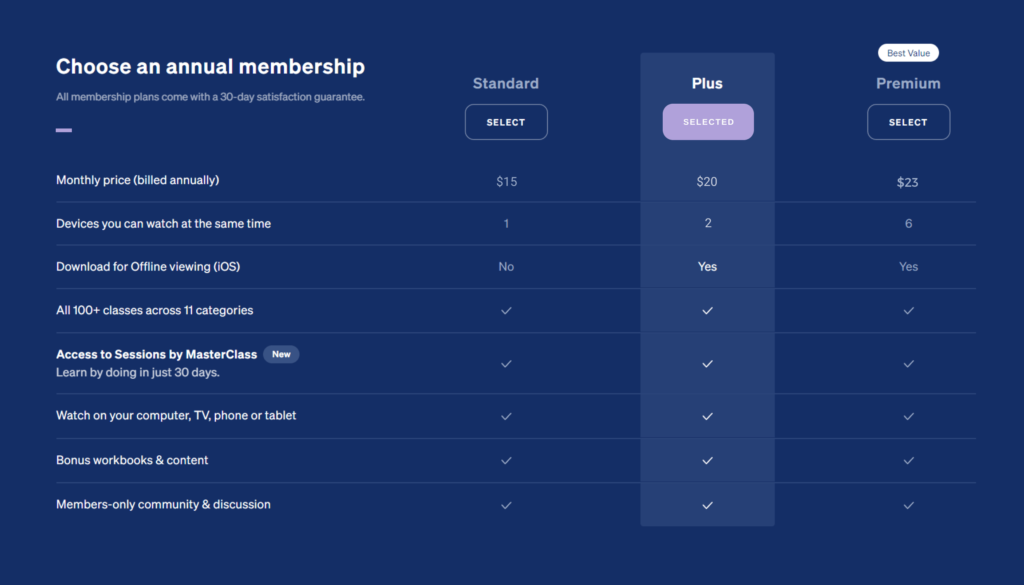
The only real differences between the three pricing plans are how many devices you can use to watch courses and being able to download courses offline.
Find out more about MasterClass
What is included in the Margaret Atwood MasterClass?
Runtime: 3 hours 43 minutes
Course Value: 4.5 out of 5
Lessons: 23
Supplementary materials: Course workbook and access to the MasterClass Hub
Supplementary workbook
Atwood’s MasterClass comes with a 92-page supplementary workbook.
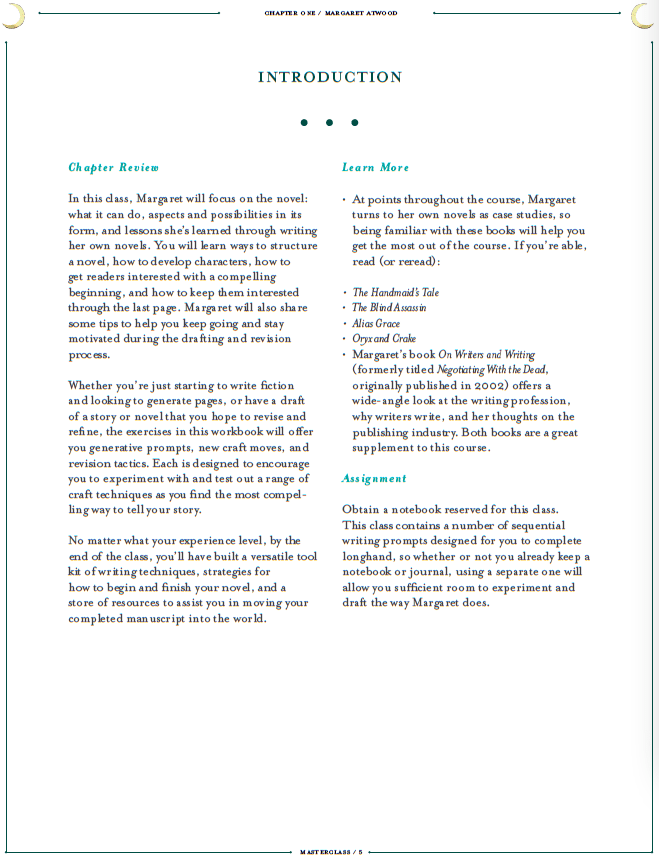
It sums up all the information from the video lessons and provides some assignments to further your learning. It also links to some useful external resources. And as you can imagine, it’s pretty well written.
The MasterClass Hub
Every course comes with access to the MasterClass Hub. It’s an online community where participants can connect, share information, and ask questions.
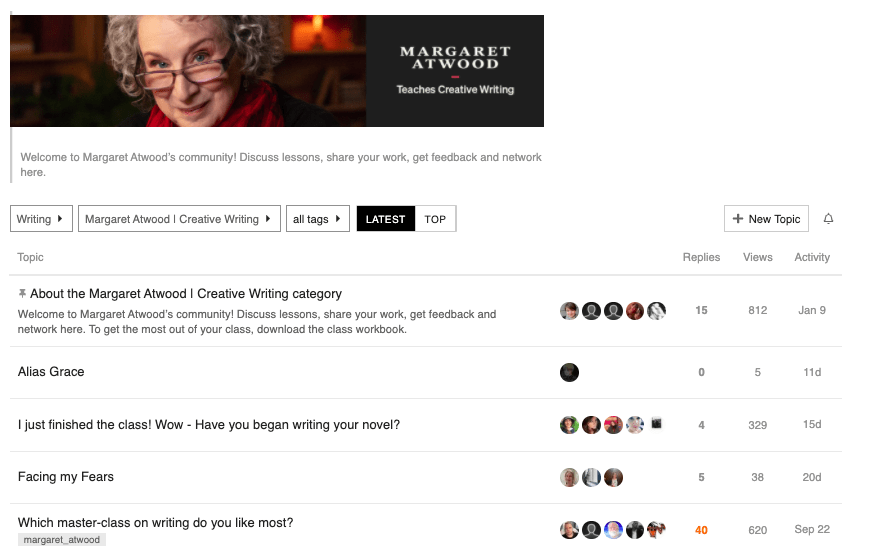
The Margaret Atwood MasterClass Hub isn’t incredibly active. But there are a lot of useful tips from other writers when it comes to your writing — you’ll just have to flick through what’s already there.
Here’s an example of someone asking for support overcoming an issue with the point of view in their writing:
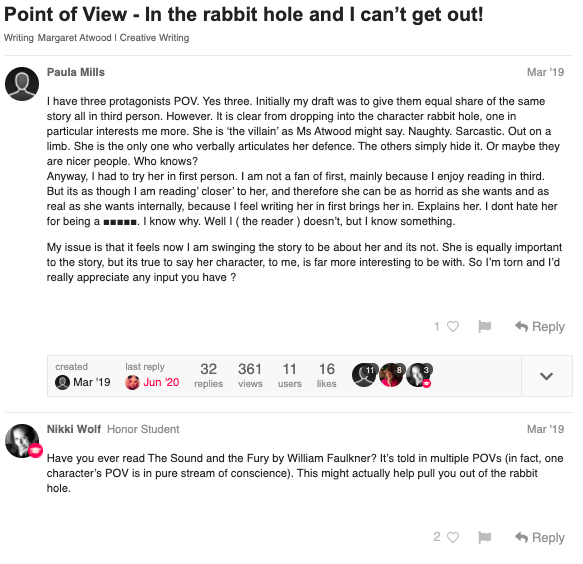
You can also filter responses in the Hub, so you can choose what topics to see if there is something specific you want to read about.
A complete breakdown of the Margaret Atwood MasterClass curriculum
This MasterClass course is just under 4 hours and is split into 23 video lessons. Here’s the full list of what it covers:
Curriculum:
- Introduction
- Getting Started as a Writer
- Story and Plot
- Structuring Your Novel: Layered Narratives and Other Variations
- Who Tells The Story: Narrative Point of View
- Point of View Case Studies
- Bringing Characters to Life Through Detail
- Creating Compelling Characters
- Writing Through Roadblocks
- Crafting Dialogue
- Revealing the World Through Sensory Imagery
- Prose Style and Texture
- Worth With Time in Fiction
- The Door to Your Book: The Importance of the First Five Pages
- Writing the Middle and Ending
- Revision: Seeing Your Work Anew
- The Novel and the Shifting Sands of Genre
- Speculative Fiction
- Speculative Fiction Case Study: The Handmaid’s Tale
- Research and Historical Accuracy
- The Writer’s Path
- The Business of Being a Writer
- Parting Words
Course summary:
Margaret Atwood’s MasterClass starts with a bit of background about her life and how she became a writer. It’s pretty interesting to hear her talk about the hurdles she overcame as a female writer in the 1950s–60s.

But we don’t dwell on this for long.
She quickly starts teaching us the ins and outs of creating a novel. Atwood takes us through what makes a strong plot, the importance of studying previous works, and the different ways you can structure your novel.
Spoiler alert: There are a lot.
Point of view
One topic Atwood speaks about specifically is the point of view.
To help you find the right point of view for your novel, Atwood suggests asking yourself who you’re writing it for and being clear about what you want to tell them. This will help you figure out who should be telling the story and in which person (first, second, or third) you should write.
She also reminds us that there’s no rule saying we have to have one point of view. If you want to have more than one, she’s all for it — so long as it works for the story.
Character
For Atwood, characters shouldn’t sit on a pedestal. People aren’t perfect in real-life, and this should be reflected in your writing.
Atwood also shares a diagram that she uses to help her create realistic characters. The diagram helps her identify key dates for her characters as well as important events happening in the world around them.

Doing this allows her to craft her characters around their surroundings, making them more realistic.
Dialogue
When talking about dialogue, Atwood says:
“If you’re going to have your characters talking to one another, it should be for some reason. Not just to have them chattering away.”
So there needs to be a purpose to your dialogue. It must be relevant to the story in some way.
Your dialogue should also be an accurate reflection of the time period you’re writing in. She uses Alias Grace as an example, which was set in the 19th century:
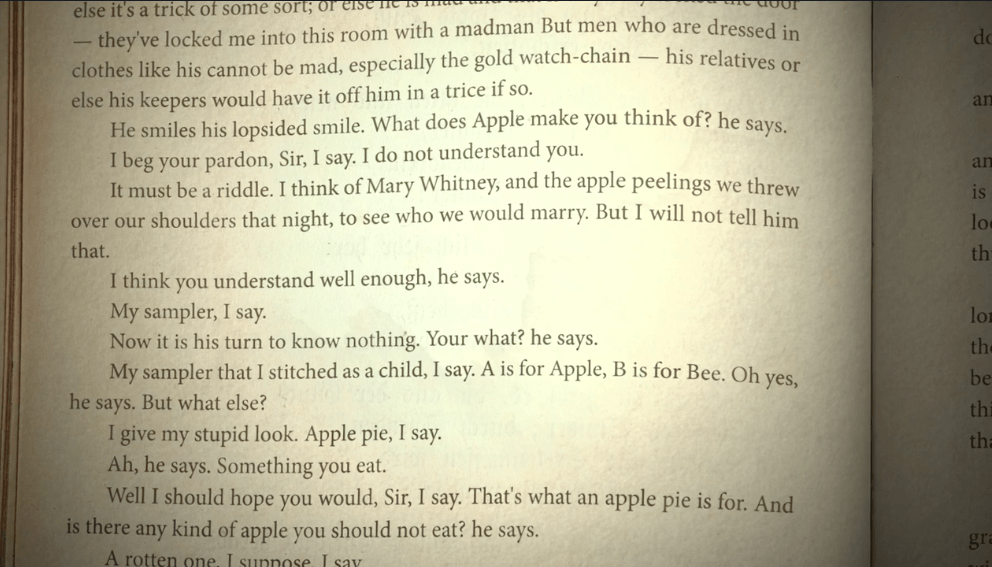
Phrases such as “I beg your pardon, Sir” are indicative of the language used at the time. Nowadays, you’re more likely to hear someone say, “What do you mean?” instead.
Speculative fiction
Atwood talks in detail about her use of speculative fiction.
If you’re not familiar with the genre, don’t worry. Its actual definition is debated among writers.
Atwood’s definition is anything that could happen in our reality but hasn’t. Her novel Oryx and Crake is a good example of speculative fiction by her definition. The novel is about a new type of human that’s been genetically designed to live on Earth.
At the time of writing, scientists had just started growing human organs in pigs. Her idea for the novel was founded in reality but speculates about what could happen in the future.
It’s an interesting approach for writers to take, and Atwood is one of the best speculative writers out there. So if that’s the type of writing you’re into, this is perfect for you.
Being a working writer
Atwood outlines what it’s like to be a working writer and how things work in the publishing industry. It’s pretty useful stuff if you want to know where to start when it comes to getting your work published.
Her main piece of advice is to find an agent who cares about you and your work. Anyone interested in a quick sale won’t stick around for long, so find someone who’s not just in it for the money.
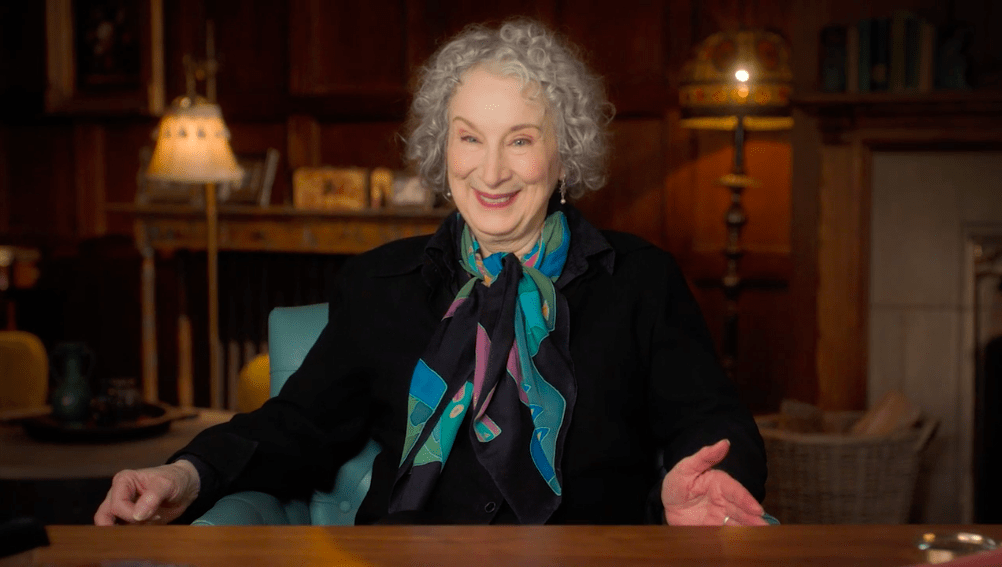
She also talks about how to deal with bad reviews and rejections from publishers and how to overcome writer’s block — all of which she’s faced over the years.
It might also be helpful to use the best writing apps or grammar checkers to enhance the quality of your writing.
What I learned
Here are some of the key takeaways I learned from Margaret Atwood’s MasterClass.
5 takeaways from this MasterClass
1. Figure out your own rules
Atwood talks at length about what works for her and other writers when it comes to writing a novel. But ultimately, she says there’s no one path to success. If something works for you, it works.
2. Every story needs a break in the pattern
In order to keep your readers interested and give your plot direction, every story needs a break in the pattern. Atwood uses the example of a gardener. Every day, the gardener tends to her rose bush in the backyard. One day, she finds a severed hand in the soil. Her example is a little morbid, but you get the gist. It’s a break of pattern for the character.
3. Use all the senses
You can use all the senses to describe what’s happening in your story. What smells are there? What can the character see? Are there any sounds? Can the character taste anything? Are they touching or holding anything? Using all the senses gives more depth to the reader.
4. Get feedback from someone outside the publishing world
Give your finished manuscript to an avid reader outside the publishing world. They can give you feedback from the perspective of a reader, not an editor or publisher.
But Atwood strongly advises against giving it to your spouse — at least if you want to avoid any awkward silences at the breakfast table.
5. Don’t research too much ahead of time
Your prose needs to be well researched, but it shouldn’t be too researched. You don’t want to be bogged down by all the details and lose track of what you’re trying to do with the story. Atwood’s advice is to start writing first, then check it out with research. Bulk out what you already have instead of basing your prose on specific research.
Take the Margaret Atwood MasterClass
Memorable quotes from this MasterClass
“If you really do want to write and you’re struggling to get started, you’re afraid of something. What is that fear?”
Lesson 2, Getting Started as a Writer
“If nothing is happening by page ten, you’re in trouble because you don’t know what the story is.”
– Lesson 4, Structuring Your Novel: Layered Narratives and Other Variations
“Does the reader know more than the character? Or does the character know more than the reader? Or do they both know the same amount? Because it’s going to be one of those three.”
Lesson 5, Who Tells the Story: Narrative Point of View
“The waste paper basket is your friend.”
Lesson 6, Point of View Case Studies
“People will leap to their own conclusions if you don’t give them enough clues.”
Lesson 7, Bringing Characters to Life Through Detail
“Likeability is a factor when you’re choosing a roommate, but it’s not necessarily a factor when you’re creating a living character.”
Lesson 8, Creating Compelling Characters
“Be kind to yourself. Take some time off. Have a break, do some stretching. This is good advice, you’ll thank me later.”
Lesson 9, Writing Through Roadblocks
Margaret Atwood MasterClass pros and cons
Let’s wrap things up with some pros and cons.
Pros
- Atwood is a knowledgeable and engaging instructor.
- The course features case studies from her work.
- Atwood is honest about the reality of being a working writer.
Cons
- The course includes a lot of references to literary classics. If you haven’t read the books, you might not fully understand the point.
- The course is aimed mostly at writing novels.
- The course length is on the shorter side.
Do I recommend this MasterClass?
Yes, I definitely recommend it. Margaret Atwood’s MasterClass is thought-provoking and interesting, and it provides budding novelists with the tools they need to write a novel as soon as the class is over.
The best thing about a MasterClass subscription is that you can expand your horizons by learning to write in various formats and genres. Each course is memorable, insightful, and one-of-a-kind. Start your membership today to unlock your creative potential.



